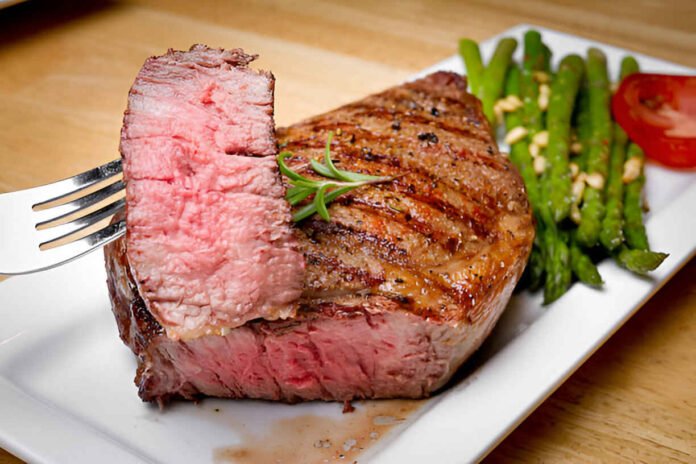If you’ve ever savored the rich, succulent flavors of a perfectly cooked medium rare steak, you know there’s nothing quite like it. Achieving that ideal balance of tenderness, juiciness, and flavor can seem elusive, but fear not! In this blog, we’ll unlock the secrets to mastering the art of cooking medium rare steak every time. Whether you’re a seasoned grill master or a novice in the kitchen, our expert tips and techniques will guide you through the process, ensuring that each steak you serve is a mouthwatering masterpiece. Get ready to impress your family and friends with steakhouse-quality meals right at home!
What is Medium-Rare?
Before we dive into the secrets of cooking the perfect medium rare steak, let’s first define what this term means. Medium rare is a doneness level that falls between rare and medium on the steak doneness scale. A medium rare steak is typically characterized by a warm, red center with a cool, bright red or pink color. The exterior should have a nice sear, while the interior should be slightly firmer than rare but still tender and juicy. When cooked to this doneness, the steak will have a rich, beefy flavor that is enhanced by the sear. Medium rare is often considered the optimal doneness for many steak enthusiasts, as it allows the natural flavors of the meat to shine while still being tender and easy to chew. For more information on this journey visit life maintain.
Choosing the Right Cut
Selecting the right cut of meat is crucial for achieving a perfectly juicy medium rare steak. Different cuts offer varying textures, flavors, and levels of tenderness, so understanding your options can make all the difference in your culinary success. Here are some of the best cuts to consider:
1. Ribeye
The ribeye is renowned for its rich marbling and robust flavor. The fat content not only enhances the taste but also keeps the steak juicy during cooking. This cut is ideal for those who appreciate a tender, flavorful bite.
2. New York Strip
Also known as the strip loin, this cut strikes a balance between tenderness and flavor. It has a firmer texture than ribeye but still boasts a good amount of marbling. The New York strip is a popular choice for steak lovers seeking a satisfying chew without sacrificing juiciness.
3. Filet Mignon
For those who prioritize tenderness, filet mignon is the go-to option. This cut comes from the tenderloin and is incredibly soft, making it a favorite for special occasions. While it has less fat than other cuts, it can still be cooked to medium rare with a deliciously juicy result.
4. T-Bone or Porterhouse
These cuts offer the best of both worlds, featuring a T-shaped bone that separates two types of steak: the tenderloin and the strip. The porterhouse is larger and includes more tenderloin, while the T-bone is slightly smaller. Both cuts are excellent choices for grilling and can be cooked to medium rare perfection.
5. Sirloin
Sirloin steaks are a more economical option that still delivers great flavor and tenderness. While they may not be as rich in fat as ribeye or strip steaks, they can still be cooked to medium rare and enjoyed with a variety of seasonings and marinades.
Prepping for Success
Preparing your steak properly is essential for achieving that perfect medium rare doneness. Follow these steps to set yourself up for success:
1. Let the Steak Come to Room Temperature
Before cooking, remove your steak from the refrigerator and let it sit at room temperature for about 30 minutes. This allows the meat to relax and cook more evenly. Avoid cooking cold steak straight from the fridge, as it can lead to an uneven cook.
2. Pat the Steak Dry
Use paper towels to gently pat the surface of the steak until it’s completely dry. This helps create a better sear and prevents steaming, which can lead to a gray, unappetizing exterior.
3. Season Generously
Liberally season your steak with salt and pepper, or your preferred seasoning blend. Be sure to season both sides and the edges for maximum flavor. Allow the seasoned steak to sit for about 15 minutes before cooking to allow the flavors to penetrate the meat.
4. Choose the Right Cooking Method
Decide whether you’ll be grilling, pan-searing, or broiling your steak. Each method has its own advantages, so choose the one that best suits your preferences and equipment. Grilling adds a delicious smoky flavor, while pan-searing creates a crisp crust. Broiling is a great option for those without a grill or stovetop.
5. Preheat Your Cooking Surface
Whether you’re using a grill, cast-iron skillet, or broiler, make sure your cooking surface is hot before adding the steak. For grilling, aim for medium-high to high heat. For pan-searing, the pan should be smoking hot. , position the rack about 4-6 inches from the heat source and preheat your oven to its highest setting.
Cooking to Perfection
Now that you’ve prepared your steak, it’s time to cook it to perfection! Follow these essential steps to ensure your medium rare steak turns out juicy, flavorful, and beautifully seared.
1. Sear the Steak
For Grilling:
- Place the steak on the grill grates and let it sear without moving it for about 4-5 minutes. This allows for a nice crust to form.
- After the first side is well-seared, flip the steak using tongs and cook for an additional 3-4 minutes on the other side.
For Pan-Searing:
- Add a high smoke point oil (like canola or avocado oil) to your preheated skillet. Once the oil shimmers, place the steak in the pan.
- Sear for 3-5 minutes without moving it to achieve a golden-brown crust. Flip the steak and cook for another 3-4 minutes on the other side.
2. Use a Meat Thermometer
To ensure your steak reaches the perfect medium rare doneness, use an instant-read meat thermometer. Insert the thermometer into the thickest part of the steak, avoiding any bone or fat. For medium rare, look for an internal temperature of 130°F to 135°F (54°C to 57°C).
3. Consider Carryover Cooking
Remember that the steak will continue to cook slightly after being removed from the heat due to carryover cooking. To account for this, consider taking the steak off the heat when it reaches around 125°F to 130°F (52°C to 54°C). It will rise to the desired temperature as it rests.
4. Let It Rest
Once your steak has reached the desired temperature, transfer it to a cutting board and let it rest for about 5-10 minutes. This resting period allows the juices to redistribute throughout the meat, ensuring each bite is tender and juicy. Cover the steak loosely with foil to keep it warm while it rests.
5. Slice and Serve
After resting, it’s time to slice and serve your perfectly cooked medium rare steak. Use a sharp knife to cut against the grain, which helps break down the muscle fibers and enhances tenderness. Serve with your favorite sides, sauces, or toppings for a complete meal.
Resting and Slicing
After cooking your medium rare steak to perfection, the final steps of resting and slicing are crucial for ensuring that every bite is as juicy and flavorful as possible. Here’s how to do it right:
1. Allow the Steak to Rest
Resting is an essential step that many home cooks overlook. After removing the steak from the heat, let it rest for about 5 to 10 minutes on a cutting board or plate. This resting period allows the juices, which are driven to the center of the steak during cooking, to redistribute throughout the meat. If you skip this step, you risk losing those flavorful juices when you cut into the steak.
- Tip: To keep the steak warm while it rests, loosely cover it with aluminum foil. This will help retain heat without causing the crust to steam and lose its crispiness.
2. Choose the Right Knife
When it’s time to slice your steak, using the right knife is key. A sharp chef’s knife or a carving knife will make clean cuts, preserving the steak’s texture and juices. Avoid serrated knives as they can tear the meat rather than slice it cleanly.
3. Slice Against the Grain
To maximize tenderness, always slice your steak against the grain. The grain refers to the direction in which the muscle fibers run. Cutting against the grain shortens these fibers, making the meat easier to chew.
- Identifying the Grain: Look for the lines or striations in the meat. Position your knife perpendicular to these lines for the best results.
4. Serve Immediately
Once sliced, serve your medium rare steak immediately to enjoy it at its best. You can plate the slices with your favorite sides, drizzle with a sauce, or top with compound butter for an extra touch of flavor.
5. Enjoy the Experience
Finally, take a moment to appreciate your culinary achievement. A perfectly cooked medium rare steak is a delicious reward for your efforts, and sharing it with family and friends makes the experience even more enjoyable.
Pairing Your Steak
To elevate your medium rare steak experience, consider the art of pairing it with complementary flavors and sides that enhance its rich, beefy profile. The right accompaniments can transform a simple meal into a gourmet feast. Here are some excellent pairing options:
1. Side Dishes
- Classic Mashed Potatoes: Creamy mashed potatoes provide a comforting contrast to the savory steak. Consider adding garlic or herbs for an extra layer of flavor.
- Grilled Vegetables: Seasonal vegetables like asparagus, bell peppers, or zucchini, grilled to perfection, add a fresh and vibrant touch to your plate.
- Sautéed Greens: Leafy greens such as spinach or kale, lightly sautéed with garlic and olive oil, offer a nutritious and flavorful side that balances the richness of the steak.
2. Sauces and Condiments
- Chimichurri: This vibrant Argentinian sauce made from parsley, garlic, vinegar, and olive oil adds a zesty kick that complements the steak beautifully.
- Red Wine Reduction: A rich red wine sauce can enhance the steak’s flavor, providing a luxurious finish to your dish.
- Compound Butter: A pat of herb-infused butter melting over your steak adds a luscious finish and an extra layer of flavor.
3. Wine Pairings
- Cabernet Sauvignon: This full-bodied red wine is a classic pairing for steak, with its bold tannins and dark fruit flavors complementing the richness of the meat.
- Malbec: Known for its smoothness and fruity notes, Malbec pairs wonderfully with grilled steaks, enhancing the overall dining experience.
- Syrah/Shiraz: With its peppery notes and robust character, Syrah or Shiraz can stand up to the flavors of a well-cooked steak.
Conclusion
Mastering the art of cooking a perfectly juicy medium rare steak is a rewarding endeavor that can elevate any dining experience. By understanding the nuances of selecting the right cut, preparing it with care, and employing precise cooking techniques, you can achieve steakhouse-quality results right in your own kitchen. Remember to allow your steak to rest before slicing, and don’t overlook the importance of thoughtful pairings that enhance its rich flavors. Whether enjoyed on a special occasion or as a delightful weeknight meal, a perfectly cooked medium rare steak is sure to impress family and friends alike. So fire up your grill or heat your skillet, and get ready to savor the deliciousness of a steak cooked to perfection!

